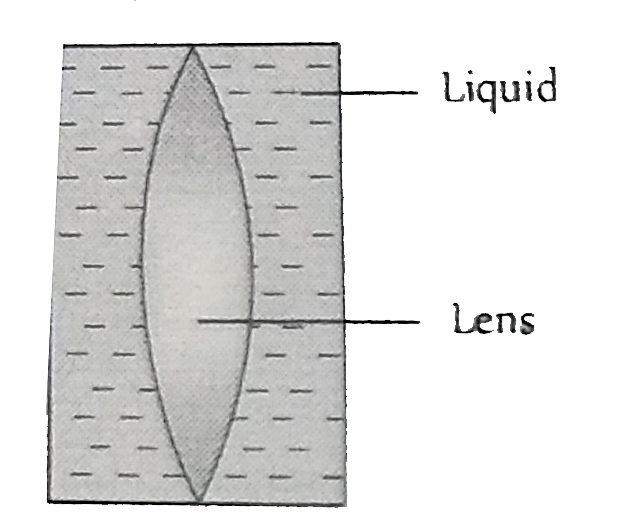The refractive index of a lens material is 1.5 and focal length f. Due to some chemical changes in the material, its refractive index has increased by 2%. The percentage change in its focal length is
+4.5%
−4.5%
+5.6%
−5.67%
The correct Answer is:D
To solve the problem, we will follow these steps:
Step 1: Understand the relationship between refractive index and focal length
The lens maker's formula relates the focal length (F) of a lens to its refractive index (μ) and the radii of curvature (r1 and r2) of the lens surfaces. The formula is given by:
1F=(μ−1)(1r1+1r2)
Step 2: Define the initial conditions
Given:
- Initial refractive index, μ=1.5
- Focal length, F
Step 3: Calculate the new refractive index
The refractive index increases by 2%. Therefore, the new refractive index μ′ can be calculated as:
μ′=μ+0.02⋅μ=1.5+0.02⋅1.5=1.5×1.02=1.53
Step 4: Write the new focal length using the new refractive index
Using the lens maker's formula for the new focal length F′:
1F′=(μ′−1)(1r1+1r2)
Step 5: Set up the ratio of the old and new focal lengths
Dividing the original and new equations gives:
FF′=μ′−1μ−1
Substituting the values of μ and μ′:
FF′=1.53−11.5−1=0.530.5
Step 6: Solve for the new focal length
Rearranging gives:
F′=F⋅0.50.53
Step 7: Calculate the percentage change in focal length
The percentage change in focal length can be calculated using the formula:
Percentage change=F−F′F×100
Substituting F′:
Percentage change=F−(F⋅0.50.53)F×100
This simplifies to:
Percentage change=(1−0.50.53)×100
Calculating the fraction:
1−0.50.53=1−0.943396=0.056604
Thus,
Percentage change≈0.056604×100≈5.66%
Since the focal length decreases, we can express it as:
Percentage change≈−5.66%
Final Answer
The percentage change in the focal length is approximately -5.66%.
---
The lens maker's formula relates the focal length (F) of a lens to its refractive index (μ) and the radii of curvature (r1 and r2) of the lens surfaces. The formula is given by:
Given:
- Initial refractive index, μ=1.5
- Focal length, F
The refractive index increases by 2%. Therefore, the new refractive index μ′ can be calculated as:
Using the lens maker's formula for the new focal length F′:
Dividing the original and new equations gives:
Rearranging gives:
The percentage change in focal length can be calculated using the formula:
The percentage change in the focal length is approximately -5.66%.
Topper's Solved these Questions
- GEOMETRICAL OPTICSBook:AAKASH SERIESChapter:GEOMETRICAL OPTICSExercise:ADDITIONAL PRACTICE EXERCISE -I (LEVEL-II LECTURE SHEET (ADVANCED) STRAIGHT OBJECTIVE TYPE QUESTIONS)
Explore 29 Videos
- GEOMETRICAL OPTICSBook:AAKASH SERIESChapter:GEOMETRICAL OPTICSExercise:ADDITIONAL PRACTICE EXERCISE -I (LEVEL-II LECTURE SHEET (ADVANCED) MORE THAN ONE CORRECT TYPE QUESTIONS)
Explore 3 Videos
- GEOMETRICAL OPTICSBook:AAKASH SERIESChapter:GEOMETRICAL OPTICSExercise:PRACTICE SHEET (EXERCISE III LEVEL -II (ADVANCED) INTEGER TYPE QUESTIONS)
Explore 4 Videos
- ELEMENTS OF VECTORSBook:AAKASH SERIESChapter:ELEMENTS OF VECTORSExercise:QUESTIONS FOR DESCRIPTIVE ANSWERS
Explore 10 Videos
- LAWS OF MOTIONBook:AAKASH SERIESChapter:LAWS OF MOTIONExercise:PRACTICE EXERCISE
Explore 106 Videos
Similar Questions
Shown in the figure here is a convergent lens placed inside a cell filled with a liquid. The lens has focal length +20cm when in air and its material has refractive index 1.50. If the liquid has refractive index 1.60, the focal length of the system is

View SolutionThe refractive index of a material of a plano-concave lens is 53, the radius of curvature is 0.3 m. The focal length of the lens in air is
View Solution
Knowledge Check
The Poisson's ratio of a material is 0.4. If a force is applied to a wire of this material, there is a decrease of cross-sectional area by 2%. The percentage increase in its length is
A3%B2.5%C1%D0.5%A convex lens is dipped in a liquid whose refractive index is equal to the refractive of the lens. Then its focal length will
Abecome zeroBbecome infiniteCremain small, but non-zeroDremain unchanged
A converging lens has a focal length of 20cm in air. It is made of a material of refractive index 1.6. If it is immersed in a liquid of refractive index 1.3, what will be its new foacl length ?
View Solution(i) If f=+0.5m, what is the power of the lens ?
(ii) The radii of curvature of the faces of a double convex lens are 9cmand15cm. Its focal length is 12cm. What is the refractive index of glass ?
(iii) A convex lens has 20cm focal length in air. What is the focal length in water ? (Refractive index of air-water =1.33, refractive index of air-glass =1.5).
View SolutionThe refractive index of the material ofa double convex lens is 1.5 and its focal length is 5 cm. If the radii of curvature are equal, the value of the radius of curvature (in cm) is
View SolutionThe focal length of lens of refractive index 1.5 in air is 30cm When it is immersed in water of refractive index 43 ,then its focal length will be
View SolutionFocal length of a lens in air is f. Refractive index of the lens is μ. Focal length changes to f1 if lens is immersed in a liquid of refractive index μ2 and it becomes f2 if the lens is immersed in a liquid of refractive index 2μ. Then
View SolutionA thin convex lens of refractive index 1.5cm has 20cm focal length in air. If the lens in completely immersed in a liquid of refractive index. 1.6, then its focal length will be
View Solution